Fracking 101
Hydraulic fracturing has upended the global energy landscape and made fossil fuels big business in the United States. Mounting evidence shows that it poses serious threats to our health, environment, and climate future. Here’s a look at the fracking boom and its increasing risks.
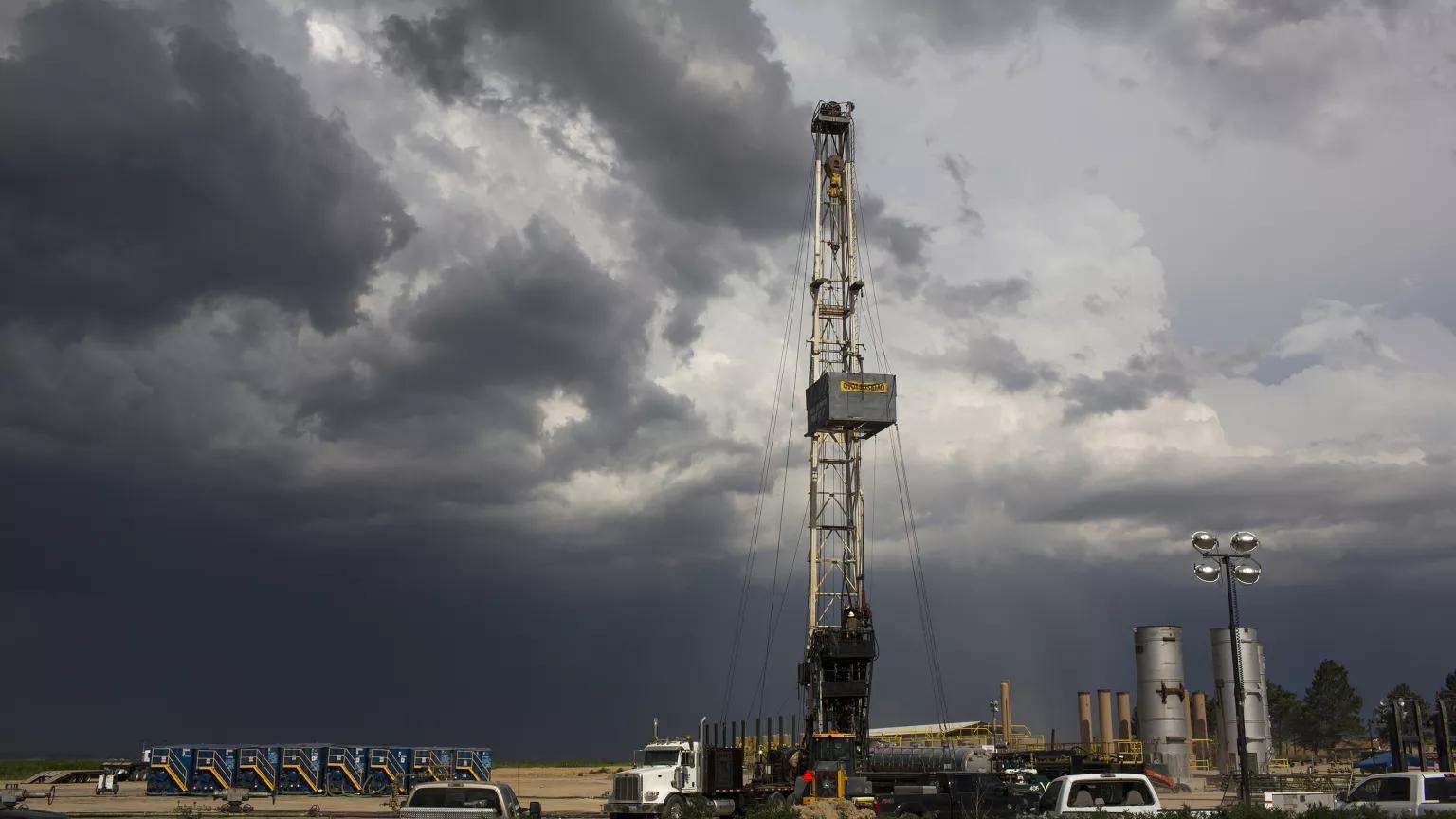
Rig in Colorado working on a Niobrara shale formation well
© Les Stone / Greenpeace
It took some time for hydraulic fracturing—or “fracking”—to become as widespread as it is today. Although American entrepreneurs have known for more than a century how to crack open rocks deep below the earth’s surface to access trapped fossil fuel deposits, fracking gained a serious foothold in the nation’s energy market only in the past two decades. During this time, a fracking boom has helped the United States become the global leader in natural gas and crude oil production. But the extraction of dirty fossil fuels by any means comes at a cost, and the risks associated with fracking to the environment, our health, and the earth’s climate are serious. Here’s a look at the fracking boom and the perils it presents.
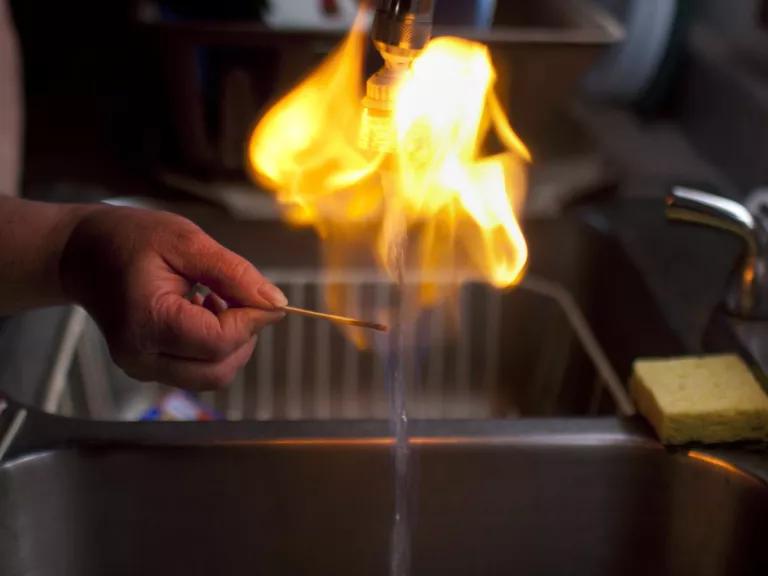
A resident of Bradford County, Pennsylvania, is able to ignite the water coming out of her kitchen faucet because of methane that has seeped into her well. Many homes in rural areas rely on private wells for drinking water.
© Les Stone / Greenpeace
What is fracking?
Modern high-volume hydraulic fracturing is a technique used to enable the extraction of natural gas or oil from shale and other forms of “tight” rock (in other words, impermeable rock formations that lock in oil and gas and make fossil fuel production difficult). Large quantities of water, chemicals, and sand are blasted into these formations at pressures high enough to crack the rock, allowing the once-trapped gas and oil to flow to the surface.
History of fracking
The idea for fracking—or “shooting the well,” as the practice was once referred to—dates back to 1862 and has been credited to a Colonel Edward A. L. Roberts. In the midst of fighting during the Civil War’s Battle of Fredericksburg, Roberts noted the impact that artillery had on narrow, water-filled channels. A few years later, he applied his battlefield observations to the design of an “exploding torpedo” that could be lowered into an oil well and detonated, shattering surrounding rock. When water was then pumped into the well, oil flows increased—in some cases by as much as 1,200 percent—and fracking was established as a way to increase a well’s productive potential.
In the 1940s, explosives were replaced with high-pressure blasts of liquids, and so “hydraulic” fracking became the standard in the oil and gas industry. It wasn’t until the beginning of the 21st century, however, that two key changes helped spark fracking’s current boom. One was the use of a certain type of fracturing fluid: slickwater, a mix of water, sand, and chemicals to make the fluid less viscous. The other innovation was the pairing of fracking with horizontal drilling, a technique that increases the productive potential of each well because it can reach more of the rock formation that contains the oil and gas. These advances, combined with an influx of investment amid high global fossil fuel prices, sent fracking into overdrive. Indeed, of the approximately one million U.S. wells that were fractured between 1940 and 2014, about one-third of those were fractured after 2000.
How does fracking work?
It involves blasting fluid deep below the earth’s surface to crack sedimentary rock formations—this includes shale, sandstone, limestone, and carbonite—to unlock natural gas and crude oil reserves.
The process begins with the drilling of a long vertical or angled well that can extend a mile or more into the earth. As the well nears the rock formation where the natural gas or oil lies, drilling then gradually turns horizontal and extends as far as thousands of feet. Steel pipes called casings are inserted into the well, and the space between the rock and the casing is fully or partially filled with cement. Small holes are made in the casing with a perforating gun, or the well is constructed with pre-perforated pipe. Fracking fluid is then pumped in at a pressure high enough to create new fractures or open existing ones in the surrounding rock. This allows the oil or gas to flow to the surface for gathering, processing, and transportation, along with contaminated wastewater that is stored in pits and tanks or disposed of in underground wells.
Fracking equipment
Hydraulic fracturing requires an extensive amount of equipment, such as high-pressure, high-volume fracking pumps; blenders for fracking fluids; and storage tanks for water, sand, chemicals, and wastewater. This infrastructure, plus more, typically arrives at drill sites via heavy trucks.
What is in fracking fluid?
Made up of as much as 97 percent water, fracking fluid also contains chemical additives and proppants (small, solid particles used to keep the fractures in the rock formation open after the pressure from injection subsides). While most states with oil and gas production now have rules requiring disclosure of chemicals used in fracking, those rules often contain exclusions for “confidential business information” (CBI), which can be used to shield the identities of chemicals that are considered trade secrets. The U.S. Environmental Protection Agency (EPA) examined more than 39,000 chemical disclosure forms submitted to FracFocus from January 1, 2011, to February 28, 2013; it found that more than 70 percent of the forms listed at least one chemical as CBI and that 11 percent of all chemicals were claimed as such.
Chemicals used in fracking
Different chemicals are added for different purposes, based on the rock type and other specifics of a fracking site. Acids, for example, are used to dissolve minerals to help fossil fuels flow more easily; biocides eliminate bacteria; gelling agents help carry proppants into fractures; and corrosion inhibitors prevent steel parts of the well from being damaged by fracking fluid. The EPA identified 1,084 different chemicals reported as used in fracking formulas between 2005 and 2013. Common ingredients include methanol, ethylene glycol, and propargyl alcohol. Those chemicals, along with many others used in fracking fluid, are considered hazardous to human health. Meanwhile, and perhaps more disconcertingly, the potential human health impacts of the majority of chemicals used in fracking formulas are simply unknown. For instance, scientists in California found that complete information about hazards and risks to humans and the environment is available for only about one-third of the chemicals used for fracking and other, similar operations in the state.
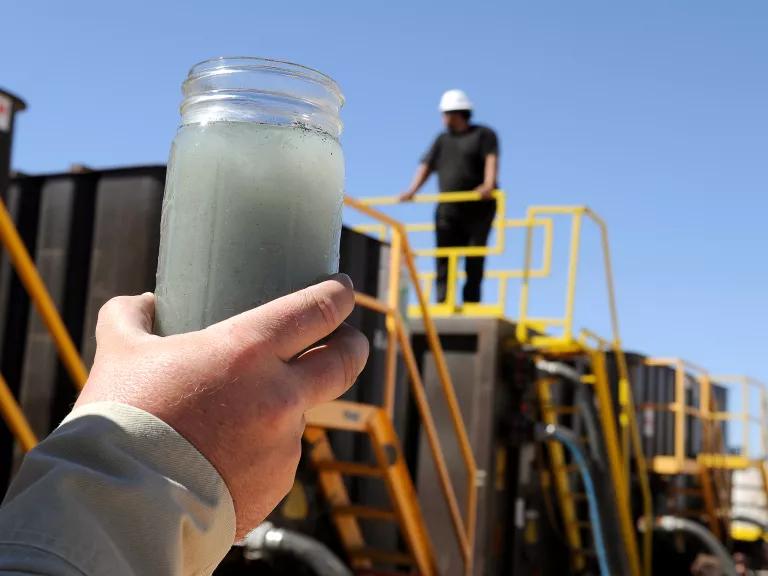
A jar of wastewater from hydraulic fracturing at a recycling site in Midland, Texas. With fresh water not as plentiful, companies have been looking for ways to recycle their waste.
Pat Sullivan/AP/Shutterstock
Proppants used in fracking
Sand is the fracking industry’s favored proppant, with high-purity quartz—known as “frac sand”—prized the most for its round shape, uniform size, and crush resistance. A single well operation can truck in thousands of tons of frac sand. According to the United States Geological Survey (USGS), the United States is the single largest producer of frac sand in the world, with almost 70 percent of 2014 domestic production coming from the Great Lakes Region, particularly from Wisconsin and Minnesota, which both saw a doubling of sand mines between 2005 and 2015.
Why is fracking bad?
While fracking has charged ahead, the research into how safe it is for human health and the environment hasn’t kept pace. Many questions remain about the dangers of the process, with mounting evidence raising serious red flags about the impact on drinking water, air pollution, and our climate.
Water supply depletion
Fracking consumes a massive amount of water. In the United States, the average can run between 1.5 million and 9.7 million gallons of water to frack a single well, according to the USGS. The amount depends on a few factors, including the type of well and rock formation. (A fracking operation in the Horn River Basin in Canada, for example, used almost 16 million gallons of water.) Water used for hydraulic fracturing is typically fresh water taken from groundwater and surface water resources. Although there are increasing efforts to use nonpotable water, some of these sources also supply drinking water. U.S. water consumption for fracking is still considered “negligible” compared with other industrial water uses (such as the cooling of coal-fired power plants). But fracking operations can strain resources in areas where freshwater supplies for drinking, irrigation, and aquatic ecosystems are scarce (and often becoming scarcer thanks to climate change). Water used for fracturing is too contaminated to return to its source without extensive treatment and so typically is disposed of deep underground, where it is removed from the freshwater cycle.
The amount of water used per frack job has grown over time, exacerbating fracking’s impact on water supplies. In fact, a Duke University analysis found that while U.S. producers scaled back on the installation of new wells between 2011 and 2016, the amount of water used for hydraulic fracturing surged. In the already drought-ridden Permian Basin region of West Texas, for example, water use for fracking during those years increased by as much as 770 percent. (Also concerning is the fact that the amount of wastewater generated during a well’s first year of production increased by as much as 1,440 percent during the study period.) The authors predicted fracking’s water footprint—the amount of water used and discarded—could increase by up to 50-fold in some regions by 2030.
Water contamination
Fracking operations not only strain water resources but risk polluting them as well. A 2016 EPA analysis found that while large data gaps and uncertainties make it difficult to fully assess the impact on drinking water, fracking operations can—and do—affect drinking water resources. The activities that pose the biggest threats include spills and leaks of fracking fluids, the injection of fluids into inadequately built wells, and poor wastewater management practices.
Fluid leaks
Spills and leaks can occur throughout the fracking process, including during the transportation of concentrated chemical additives; the mixing and pumping of fracturing fluids; and the storage, transportation, and disposal of used fracturing fluid and wastewater. Both human error and equipment failure can cause spills and leaks, and some spills are known to have reached surface water resources, according to the EPA. Indeed, the agency’s analysis of spill reports from 11 states revealed 151 spills of fracking fluids or additives between 2006 and 2012, with nearly 10 percent of those spills (ranging from 28 to 7,350 gallons) ending up in creeks, streams, or other bodies of water. The full impact can be difficult to measure, however, for many reasons, including that the chemical makeup of the spilled fluid may be unknown or poorly described, and the ultimate fate of the spilled fluids and impacts of the spill are not typically studied.
Well construction
Oil and gas wells must be properly constructed to withstand intense temperature and pressure fluctuations. Otherwise, a well may be damaged, possibly allowing oil, gas, and fracking fluid to leak. For example, the EPA faulted burst casings—the steel pipes used to construct wells—in the leakage of fracking fluids into wells used to monitor water quality in Killdeer, North Dakota, in 2010. Another study, of 133 cases of suspected drinking water contamination in Pennsylvania and Texas, pointed to faulty well construction as the likely reason behind some cases of methane pollution.
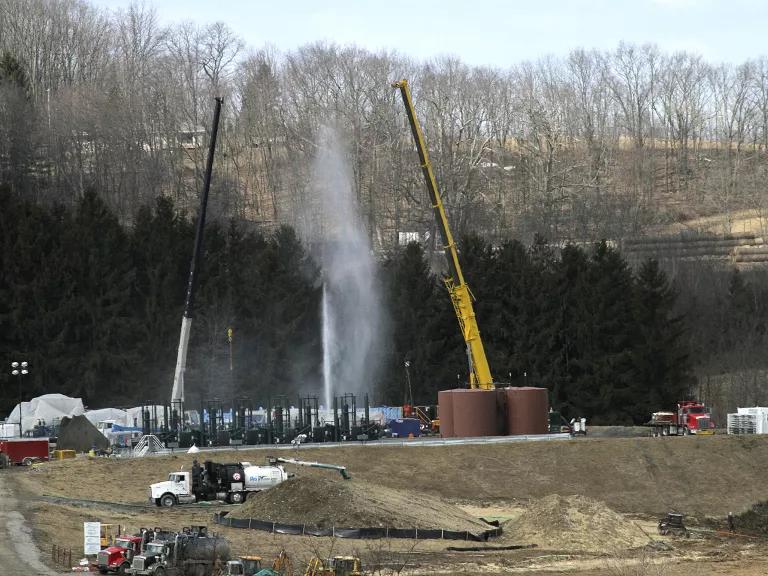
A gas well malfunctions, allowing wastewater to spray into the air in 2013. Several homes in the Wyoming County, Pennsylvania, area were evacuated and roads were closed until workers could cap the well.
Michael J. Mullen/Scranton Times & Tribune via AP
Fractured rock formations
Operators can’t completely control where fractures occur. When a fracture extends farther than intended, it can link up with a naturally occurring fault, other natural or man-made fractures, or other wells and then carry fluids to other geological formations, including, potentially, drinking water supplies. Equally concerning, according to the EPA, is the lack of data on how close induced fractures are to underground aquifers. This meant that in its 2016 assessment, the agency was often unable to determine with certainty whether fractures reached underground drinking water resources. While most fracked rock formations are separated from aquifers by thousands of feet, in some cases hydraulic fracturing occurs within a drinking water resource. For example, in the Pavillion gas field in the Wind River Basin of Wyoming the same formation that contains natural gas also provides drinking water for the nearby the town of Pavillion. While drinking water is generally shallower than the gas, there are no geologic barriers separating the two. Some private wells that provide drinking water have been contaminated with methane and other chemicals that may have escaped from the surface pits used to store wastewater or from improperly constructed production wells—although determining the exact source of the contamination is challenging.
Wastewater mismanagement
Every year, the oil and gas industry generates billions of gallons of wastewater, a potentially hazardous mixture of flowback (used fracking fluid), produced water (naturally occurring water that is released with the oil and gas), and any number of other naturally occurring contaminants ranging from heavy metals, salts, and toxic hydrocarbons like benzene to radioactive materials such as uranium. This wastewater can enter and contaminate the environment in myriad ways: when transported (in 2015, for example, a broken North Dakota pipeline carrying produced water spilled about three million gallons of contaminants into a nearby creek), when stored (open pits that hold wastewater aboveground can spill, leak, and emit air pollution), or when treated (wastewater treatment facilities unable to properly handle pollutants found in fracking waste can release contaminants into surface waters). Even the recycling of wastewater poses a threat as it generates concentrated waste products, including a by-product called TENORM (technologically enhanced naturally occurring radioactive material), which must then be properly managed. Recycled wastewater must also be appropriately treated for its intended end use, which can be challenging when companies do not fully disclose all the chemical contents.
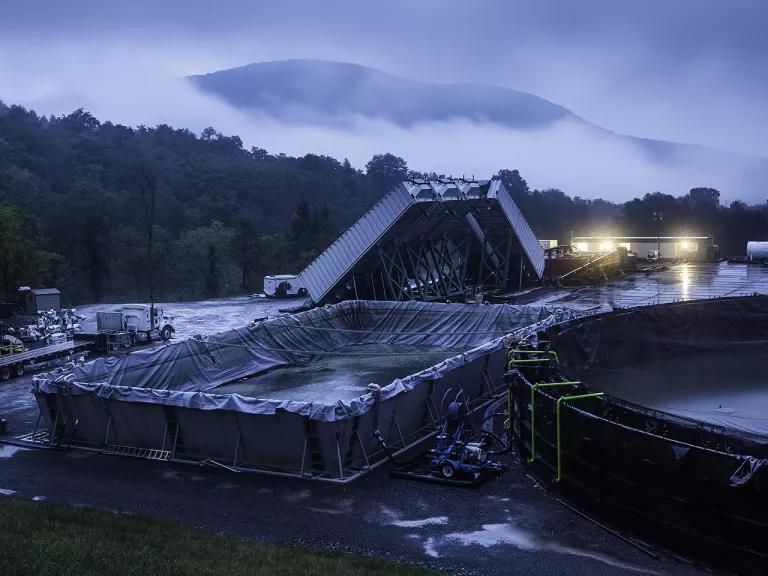
A well pad in Eldred, Pennsylvania, as seen from an adjacent backyard
Courtesy: FracTracker Alliance, fractracker.org/photos
Air pollution
Air pollution from oil and natural gas production, including fracking activities, is a serious problem that threatens the health of nearby communities. Flaring (a controlled burn used for testing, safety, and waste-management purposes), venting (the direct release of gas into the atmosphere), leaking, combustion, and release of contaminants throughout the production, processing, transmission, and distribution of oil and natural gas are significant sources of air pollution.
Natural gas is made up mostly of methane, a potent greenhouse gas that traps more than 80 times as much heat as carbon dioxide. The oil and gas sector is the largest domestic industrial source of methane pollution. When gas is flared, vented, or accidentally leaked, it accelerates the costly health impacts of climate change. Oil and gas operations, such as hydraulic fracturing, also release numerous toxic air contaminants: benzene, toluene, ethylbenzene, and xylene; fine particulate matter (PM2.5); hydrogen sulfide; silica dust; and nitrogen oxides and volatile organic compounds, which produce smog when combined. In rural northeastern Utah, researchers estimated that the amount of smog-forming compounds coming from oil and gas operations each year was equivalent to the emissions of 100 million cars. A broad range of health effects are associated with exposure to these air pollutants, including mild to severe respiratory and neurological problems, cardiovascular damage, endocrine disruption, birth defects, cancer, and premature mortality. Meanwhile, industry workers face even greater risks from on-site exposure to toxic chemicals and other airborne materials, including silica (the main component of frac sand), which can lead to lung disease and cancer when inhaled.
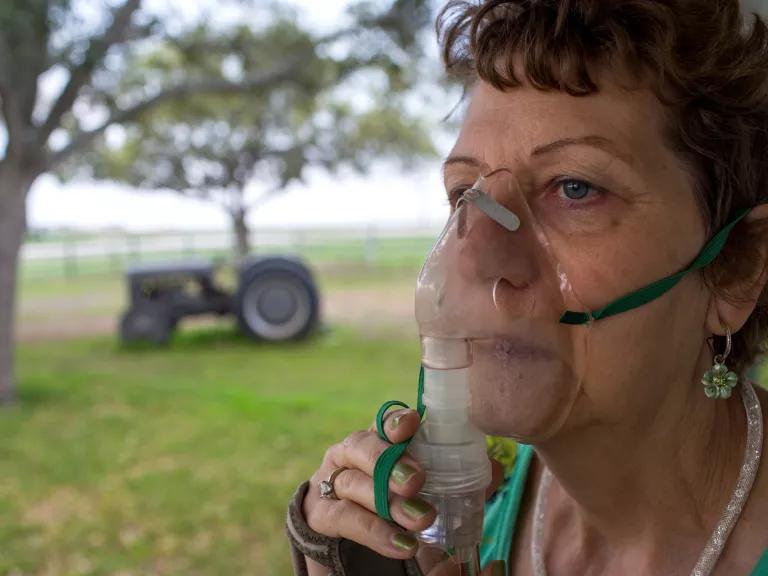
Lynn Buehring’s home in Karnes County, Texas, is situated between three fracking wells. She often uses a respirator since her breathing became difficult, allegedly as a result of the chemicals and hydrogen sulfide gas released from the wells. She is suing Marathon Oil for relief.
© Les Stone / Greenpeace
Earthquakes
Noting an “unprecedented increase” in the number of earthquakes in the central part of the United States since 2009, the USGS has determined that disposal wells—which inject wastewater generated from oil and gas operations, including fracking, deep underground—are mostly to blame. (The hydraulic fracturing process itself is likely responsible for a very small number of induced earthquakes, according to the agency.) The pressure exerted on a rock formation by the fluids injected into these disposal wells can cause faults to shift, resulting in human-induced earthquakes. The USGS has found that the central and eastern United States averaged just 25 annual earthquakes of magnitude 3 or higher (which is generally strong enough to feel) between 1973 and 2008 but experienced more than 1,000 of these quakes in 2015 alone. Oklahoma and Ohio are among the states with dramatic upticks in quakes as a result of booming oil and gas production and the need to dispose of the accompanying waste. Some of these man-made earthquakes have been large enough to cause property damage and injuries, but these states find themselves ill-equipped to deal with seismic activity, given how rare natural earthquakes are.
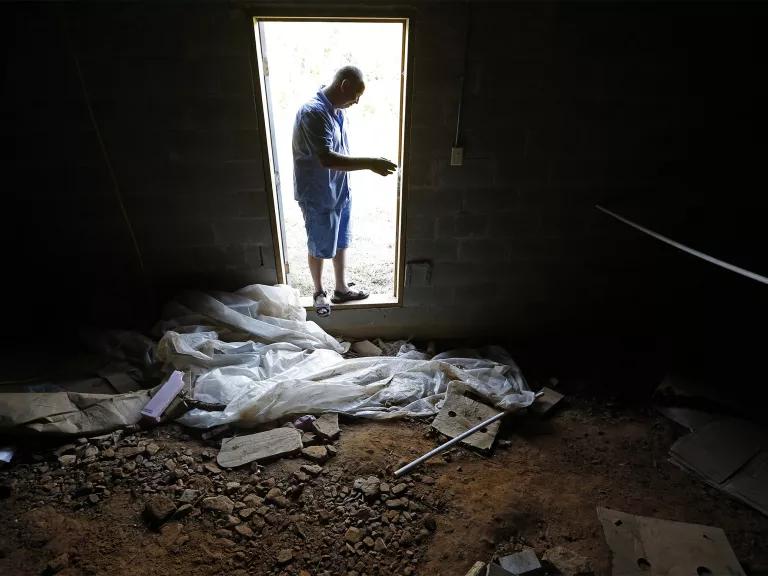
A homeowner in Greenbrier, Arkansas, says a newly built addition on his house became unsafe to live in after an earthquake in February 2011. More than a dozen homeowners in central Arkansas claim the disposal of fracking wastewater triggered a swarm of more than 1,000 minor earthquakes in 2010 and 2011 that damaged their property.
Jim Young/Reuters via Newscom
Environmental degradation
Fracking, like other oil and gas operations, involves intense industrial development. Well pads, access roads, pipelines, and utility corridors are typically accompanied by intense, round-the-clock noise, lights, and truck traffic. In addition to potentially polluting local water and air resources, this vast web of infrastructure can fragment forests and rural landscapes and degrade important wildlife habitat. One study of mule deer in northwestern Colorado, for example, found that natural gas drilling operations had compromised as much as half of the animals’ critical winter habitat. Another study, analyzing the impact of fracking wastewater sprayed on forested land in West Virginia, found that more than half of the trees in the area had died within two years.
Fracking in the United States
Since 2014, hydraulically fractured horizontal wells have accounted for the majority of new oil and natural gas wells developed in the United States, surpassing all other drilling techniques. In 2016, nearly 70 percent of the country’s 977,000 producing oil and natural gas wells were horizontally drilled and fracked. The fracking boom is largely credited with making the United States the top producer of natural gas and crude oil in the world—a trend expected to continue as fracking becomes more efficient (with fewer rigs generating greater output) and enables access to more of the country’s fossil fuel reserves.
According to the U.S. Energy Information Administration (EIA),Texas is the top producer of crude oil and natural gas. North Dakota ranks second for crude oil and Pennsylvania second for natural gas. However, about 30 states are estimated to sit above gas- and oil-rich shale and other tight rock formations (also called “plays”). The most productive U.S. shale gas plays are the Appalachia region’s Marcellus Shale, which spans New York, Pennsylvania, and West Virginia; the Permian Basin, which rests under Texas and New Mexico; and the Haynesville Shale, located beneath northeast Texas and northwest Louisiana. The most productive tight oil regions include the Permian Basin, North Dakota’s Bakken formation, and Texas’s Eagle Ford shale play. The fossil fuel industry has also set its sights on areas that offer much less potential output, such as in the Florida Everglades, including the Big Cypress National Preserve, despite tremendous environmental risks.
Fracking in Texas
Home to two of the country’s most productive unconventional plays, the Permian Basin and the Eagle Ford, Texas leads the nation in oil and natural gas production. (“Unconventional” refers to oil and gas resources in less-permeable and less-porous rock.) The state also serves as a cautionary tale for the many health and environmental consequences of fracking and other methods of fossil fuel extraction. Texas’s industries make it the top emitter of smog-forming ozone pollutants in the United States, and earthquakes are on the rise. Studies have found increased levels of harmful chemicals in water near fracking sites, suggesting that further monitoring is in order. Meanwhile, a state regulation designed to protect the public from the health impacts of fossil fuel extraction may be only loosely enforced, according to a study by Dallas news station WFAA.
Fracking in Pennsylvania
With approximately three-fifths of the state atop the Marcellus Shale play, Pennsylvania is the second-largest producer of natural gas, generating nearly one-fifth of America’s supply in 2017. Output is expected to continue to grow—though not everywhere. In 2018, the Delaware River Basin, a watershed that spans parts of Pennsylvania, New York, New Jersey, and Delaware, was marked off-limits to fracking (although the threat to drinking water and the environment hasn’t been eliminated, since some proposed regulations would still allow wastewater to be disposed of in the watershed). Meanwhile, statewide concern about fracking’s hazards is mounting: According to one 2018 poll by NPR, 55 percent of residents believe fracking’s potential environmental risks outweigh its potential economic benefits—up from 37 percent in 2014. In some cases, Pennsylvania has already seen fracking’s risks play out in the form of contaminated drinking water supplies and polluted air.
Fracking in New York
In 2015, New York became the first state with significant natural gas reserves (its southern swath sits atop the Marcellus Shale play) to prohibit fracking. The New York Department of Environmental Conservation concluded that the “significant adverse public health and environmental” threats the extraction method posed far outweighed “the limited economic and social benefits that would be derived.”
Fracking in California
California’s Monterey formation was once billed as America’s “black gold mine,” estimated to hold as much as two-thirds of the country’s unconventional oil resources—that is, until a 2014 revision slashed that estimate by about 96 percent. However, as of 2017, California was still the fourth-largest producer of oil in the nation due to significant ongoing conventional production, from the largely rural Central Valley to some of the densest urban drilling sites anywhere in the world in Los Angeles and surrounding municipalities. A 2014 analysis of oil and gas development in California showed that approximately 5.4 million people live within a mile of one of the 84,000-plus existing oil and gas wells, 3,000 of which had used either hydraulic fracturing or acidizing, which is the process in which acid is pumped into a well to dissolve rock and increase permeability. When fracking does occur in California, it differs from elsewhere in the United States, as it often occurs at shallower depths and in closer proximity to drinking water sources, increasing the risk of water contamination. Nevertheless, the Trump administration has made moves to open more than one million acres of public land in the state—much of which supplies water for agricultural and urban areas—to oil and gas drilling.
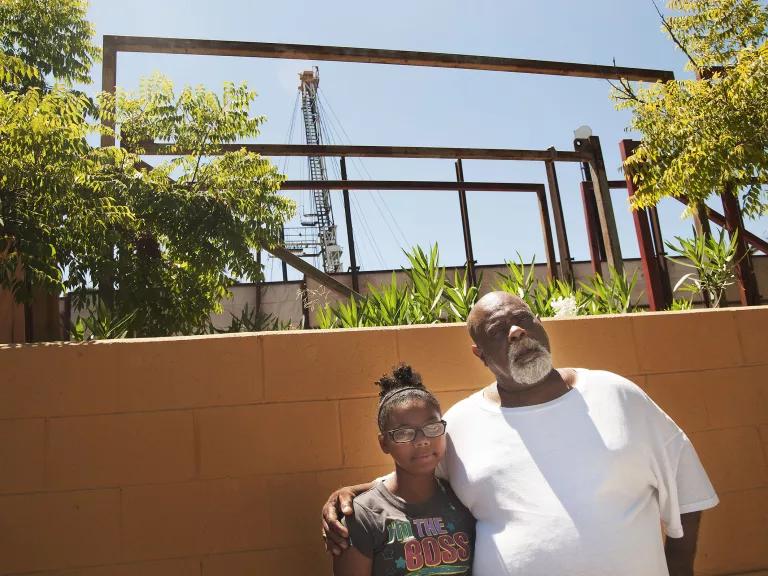
Don Martin stands with his granddaughter in front of the Murphy Oil site, located next door to his apartment in West Adams, Los Angeles.
Sarah Craig/Faces of Fracking
Fracking in North Dakota
Home to 20 of the country’s 100 largest oil fields, North Dakota sits atop the Bakken Shale and underlying Three Forks formations, themselves located in the larger Williston Basin (which spans portions of South Dakota, Montana, and the Canadian provinces of Manitoba and Saskatchewan). The nation’s number two crude oil state (behind Texas) since 2012, North Dakota shattered its own production records in 2018, in large part due to the improved efficiency of its fracking operations. This boom in production has come at a cost, however, particularly to land, air, and water resources. According to a 2016 Duke University study, wastewater spills from fracked oil wells in the Bakken region have caused “widespread and persistent” water and soil contamination with “clear evidence of direct water contamination.” And while North Dakota produces just 2 percent of the nation’s natural gas, its operations still flare a “substantial” amount, producing significant air pollution. According to a 2014 study by the National Oceanic and Atmospheric Administration, drilling and fracking operations in the Bakken oil and gas fields alone contributed as much as 3 percent of global emissions of ethane (a greenhouse gas and precursor for ozone formation).
Fracking in Florida
Although fracking is typically associated with big producers like Texas, states with far more limited oil and gas reserves are affected too. According to an expert report obtained by NRDC, both current production and the prospects for future expansion in Florida are minimal. Yet efforts continue to develop these small amounts of oil and gas, at the expense of Florida’s sensitive natural resources, including the Everglades. Florida has two oil‐producing regions: one at the western end of the Panhandle, bordering Alabama, and another in the southern part of the state, in and around the Big Cypress National Preserve, a key part of the Everglades ecosystem.
Oil well stimulation techniques such as fracking and acid matrix stimulation, or “acidizing,” facilitate production from unconventional oil deposits. Acidizing dissolves portions of the oil‐bearing rock formations through the injection of acid mixed with water and other chemicals, allowing oil to more easily flow to the well bore. In Florida, acidizing is more likely to be used than fracking due to the state’s geology. Aquifers—crucial sources of drinking water—are vulnerable to contamination because large areas are characterized by sandy soils and porous limestone. Since Florida oil fields generally lie deeper than the shallow aquifers that provide the state with fresh drinking water, acidizing techniques threaten groundwater resources. Additionally, wastewater from acidizing techniques can contain hazardous pollutants and pose threats to underground aquifers. Proposals for a statewide legislative ban on fracking and acidizing techniques have been introduced, with bipartisan support, in both houses of the state legislature.
Dozens of counties and municipalities have already said no to fracking within their respective borders—and for good reason. Oil and gas production threatens public lands, natural resources, wildlife, water supplies, and Florida tourism, a vastly larger industry in the state than oil.
Laws and regulations
Although evidence continues to mount about the negative impact of fracking on our water, air, and health, the industry remains seriously underregulated. Oil and gas operations benefit from a range of exemptions or limitations in regulatory coverage within the bedrock environmental statutes that are meant to protect Americans from contaminated water, hazardous waste, and polluted air.
Consider the “Halliburton loophole,” nicknamed for the largest oil and gas services company in the country and passed as part of the Energy Policy Act of 2005 (while former Halliburton CEO Dick Cheney was vice president). Unless diesel is used in the fracking fluid, it exempts hydraulic fracturing from regulation under the Underground Injection Control Program of the Safe Drinking Water Act, the law protecting our drinking water from pollutants.
The oil and gas industry enjoys an exemption for certain exploration and production wastes from regulation as “hazardous wastes” under the Resource Conservation and Recovery Act. Such oil and gas exploration and production wastes could include used fracking fluids, produced water, and many other types of waste. The industry also enjoys a loophole in the Clean Air Act that exempts oil and gas wells, compressor stations, and pump stations from aggregation as major sources that would otherwise have to implement pollution controls once emissions hit a certain threshold. As to the Clean Water Act, Congress exempted stormwater runoff from oil and gas exploration, production, processing, or treatment operations or transmission facilities from certain permitting requirements, provided that such stormwater is not contaminated. Bills seeking to close these and other statutory loopholes and exemptions were introduced in Congress in 2017 but have made little progress.
Meanwhile, the Trump administration is aggressively opening up more public land to fracking and proposing rollbacks of existing regulations on oil and gas operations. This includes a scaling back of methane protections as well as a repeal of fracking rules approved in 2015 by President Obama’s Bureau of Land Management. The rules, which have been held up in the courts, impose safeguards to protect water supplies from fracking on federal lands—safeguards that health and environmental advocates already believe do not go far enough.
Stricter federal oversight of the oil and gas industry would go a long way toward protecting our communities and environment, but state and local agencies can also play a significant role in governing the industry. As a counterbalance to the Halliburton loophole, for example, many states have some level of fracking chemical disclosure laws on the books (though companies often manage to skirt even those). For the most part, however, states have failed to provide adequate oversight of fracking operations, with regulations often left largely unenforced and few if any requirements to notify the public of violations and spills. But not every state is ignoring the science. Some—New York, Maryland, and Vermont—have banned fracking altogether and others, like California and Colorado, are taking important steps to provide meaningful oversight.
Alternatives to fracking
Though natural gas produces less carbon pollution than other fossil fuels when it burns, it is far from a “clean” energy source—especially when it comes to us thanks to fracking. As the science increasingly shows, the extraction of natural gas or oil via fracking can release significant amounts of air and water pollution that imperil the health of our communities and environment. It is for this reason that many municipalities have rallied against the fracking industry.
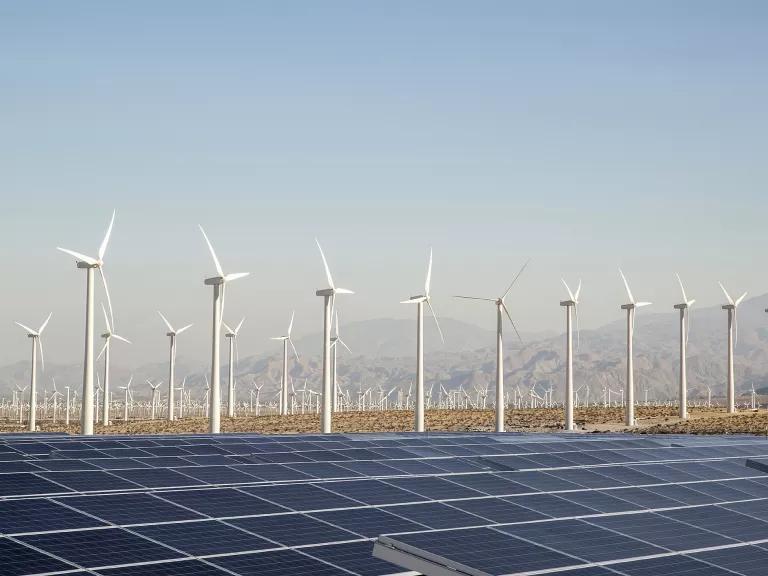
Wind turbines and solar panels in Palm Springs, California
Vanja Terzic/iStock
Instead of increasing our dependence on fracking and fossil fuels, the United States needs to continue to transition toward a truly clean energy economy. That means continuing to develop renewable power and improving energy efficiency, which has actually contributed more to the nation’s energy needs over the past 40 years than oil, coal, natural gas, or nuclear power. It’s not just the health of communities that is at stake. As the latest report by the United Nations Intergovernmental Panel on Climate Change (IPCC) warns, the world needs to quickly wean itself off fossil fuels—on a global scale—to avoid the catastrophic effects of a changing climate.
This NRDC.org story is available for online republication by news media outlets or nonprofits under these conditions: The writer(s) must be credited with a byline; you must note prominently that the story was originally published by NRDC.org and link to the original; the story cannot be edited (beyond simple things such as grammar); you can’t resell the story in any form or grant republishing rights to other outlets; you can’t republish our material wholesale or automatically—you need to select stories individually; you can’t republish the photos or graphics on our site without specific permission; you should drop us a note to let us know when you’ve used one of our stories.

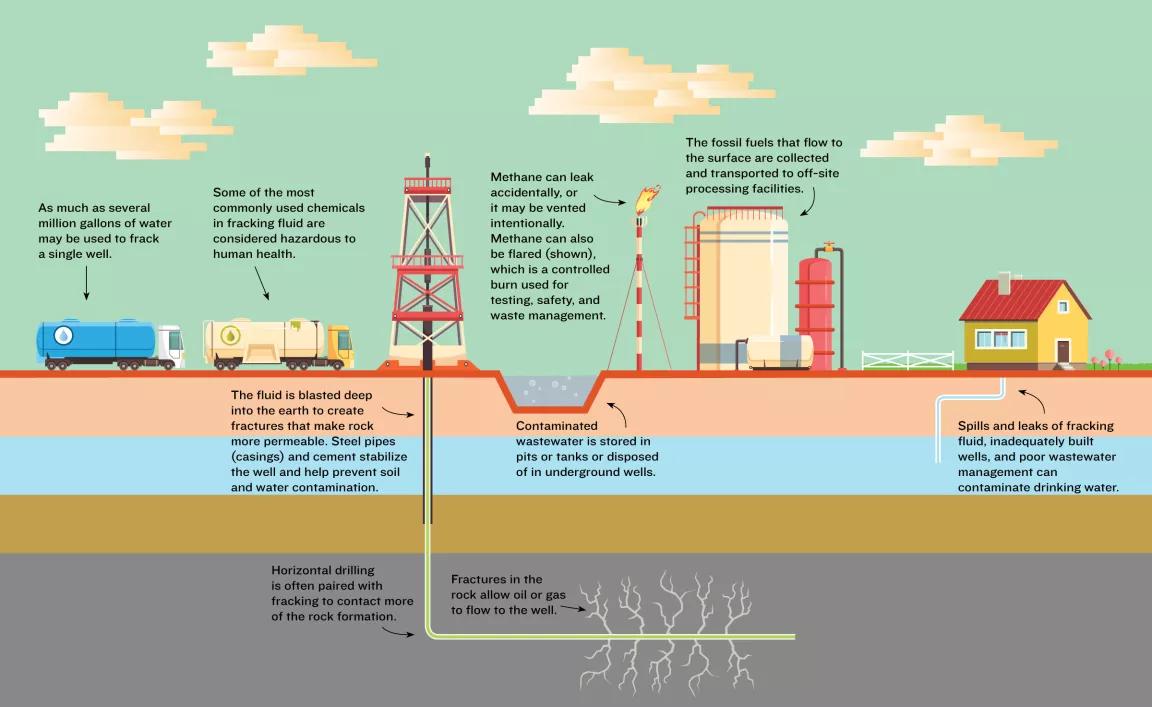
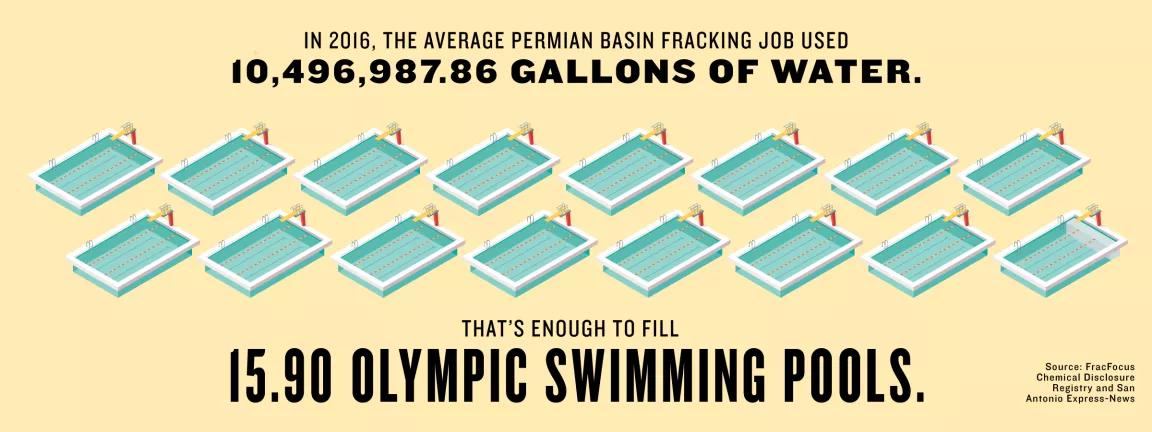
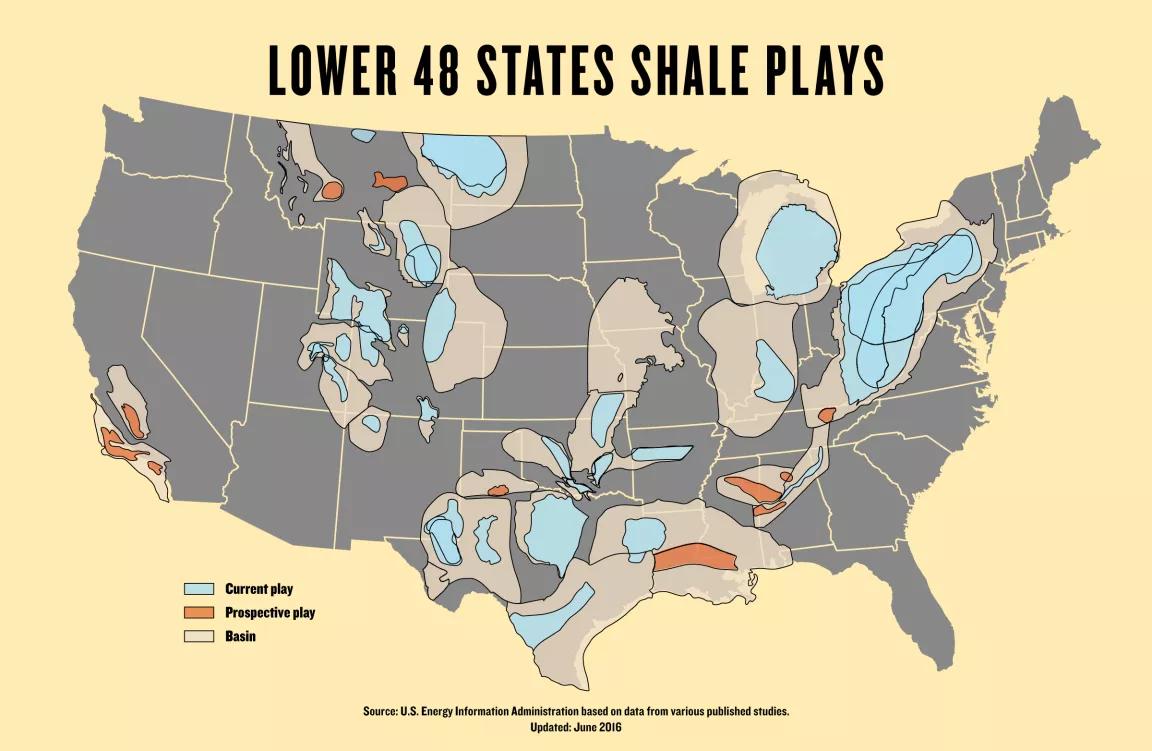
How to Tackle Fracking in Your Community
Community Science Is Changing How People Can Fight Pollution
Protect Your Community from “Bomb Trains”